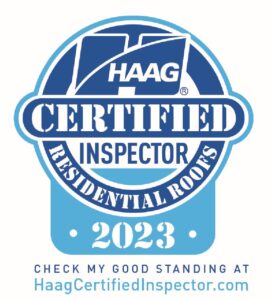How to Know Whether to Repair or Replace Your Roof
Feb 03, 2021Replacing your roof can be a bit of an undertaking, so here are the warning signs to look out for when determining whether to replace or repair your roof.
How to Know if You Need a New Roof
Replacing your roof can be a bit of an undertaking, so how do you know if it’s completely necessary to get a new one? You can start by asking yourself a few questions:
- Is your roof 20 years or older?
- Does it look worn, stained, or dilapidated?
- Did you recently experience any severe weather like a hurricane or a hail storm?
- Have you noticed any leaks in the interior of your home or discoloration on the ceiling?
- Do you notice granules or grit on the ground or by gutter downspouts after a rain?
If you answered yes to any of these, it might be a good idea to have your roof professionally inspected. Any of these issues could suggest serious underlying problems with your roof that could transform into expensive catastrophes later on. Here are a few other ways to tell if you might need to have your roof repaired or replaced.
Age
Typically, a properly installed asphalt roof can last a solid 20 years– pending any storm damage, of course. If your roof is 20 years or older, it may be time for an update. If you don’t know the exact age of your roof, keep an eye on neighbors– especially if they are getting their roofs repaired or replaced. Houses that are in the same neighborhood were typically built at or around the same time. You can also check the home inspection report that was created before you purchased your home to determine the age of your roof.
Another good thing to know about your roof is whether or not it is a single or multi-layered one. If old shingles were not removed but were simply covered over with new ones recently and you suspect that your home is older than 15 years, you will likely need to replace your roof.
Decaying Shingles
This one may seem obvious, but shingle decay is another indicator of an aging or faulty roof. By inspecting the slopes of your roof that fall in direct sunlight, you should be able to determine if your shingles are curling or losing their grittiness. If you feel that your roof is too “young” to have decaying shingles, it’s possible that it might be defective and you may be eligible for reimbursement. Reach out to a licensed roofing contractor to see if you’re eligible.
Here’s what to look for when trying to determine where your shingles measure up in the typical shingle life cycle:
- Curling: If your shingles are curling, your roof may either be reaching the end of its life (whether due to age or weathering), or it is not ventilated properly– suggesting roof leakage might be in your future. There are two types of curling shingles: cupping and clawing. Cupping happens when the edges of shingles curl upwards. Clawing shingles, on the other hand, have flat edges and a raised center.
- Buckling: If you find that your shingles appear to be rippling or waving, it could be indicative of poor workmanship, poor quality roofing materials, or a faulty roof structure as a whole.
- Cracked: More common for shingle roofing, having cracked shingles suggests that your roof has sustained serious wind damage. If a few shingles in one isolated spot are cracked, you can definitely just get them removed and replaced with new ones. If, however, the cracking is sporadic but can be found throughout your roof, it’s a good idea to start thinking about getting your roof replaced.
- Missing Shingles: This is a problem you’ll want to catch as early as you can because if it rains and the water penetrates the bald spots left by missing shingles, it could begin to rot the interior structure of your roof. If you have a few missing shingles, it may be okay to forgo getting your entire roof replaced and opt instead for replacing the missing shingles with new ones for a time. The only issue you’ll run into with this approach is the lowered aesthetic quality of your roof. Keep in mind that getting a new shingle to be a perfect color match to its old neighboring shingles is highly unlikely. If your roof begins to look like a patchwork quilt, it may be worth it to get the entire thing replaced.
- Rot: More common for wooden or asphalt roofing, rotting shingles often look as if they’re crumbling or are shrinking in size– they would also be easy to tear. Rotting shingles may also have an accumulation of mold on them, as well. Curling shingles, as mentioned before, are another sign that you might have rotting shingles. Look also for strange bulges and bubbles in your shingles as well as warping and buckling on the roofline. The latter may suggest that the rot is compromising the structural integrity of your roof. This should be remedied immediately.
Granule Loss
Another way to gauge the health of your roof is to check your gutters for granule loss. Granules are important because they help keep the sun off the shingles to prevent shingles from baking and quickly deteriorating, but if enough of them are missing, it could cause quite a bit of damage.
Where it is common to find shingle granules in the gutters if you just had a new roof installed, if it has been 10 years or more and you’re finding a large number of granules by gutter downspouts, your roof may be reaching the end of its life.
If you’re questioning yourself, grab a ladder, and inspect the shingles themselves. If a small number of your shingles have large bald patches of smooth, weathered asphalt, you will need to replace them individually. However, if this problem is more widespread, consider having a contractor come out to assess your roof and help you decide the best course of action.
Decaying or Missing Shingles in your Roof Valley
A roof valley is the place where two downward sloping parts of your roof meet. This valley is one of the most integral areas of your roof as it’s where snow and rain are funneled into your gutters. If shingles are missing, falling apart, or decaying in this particular area, it’s time to invest in a new roof. Leaving the valley in disrepair will make your roof susceptible to leaking and culminate in eventual structural roof damage.
Moss, Algae, and Lichen Buildup
If you live in a cool, dimly lit, humid area, you may notice that the north side of your roof is covered in green patches. These patches may seem like more of an eyesore than anything else and sometimes, that’s all they are– but it isn’t always the case.
Because moss traps moisture, it can become quite a pest for your shingles during the winter months. In freezing temperatures, damp moss can cause a lot of damage to granules and the tops of shingles. Over time, the repetitive freezing and thawing of moss patches can cause your shingles to lose granules and make them virtually useless. Lichen, however, is an acidic mixture of algae and fungus; though they trap less moisture than moss, they have roots that can penetrate through your shingles and cause some serious damage.
Brushing the moss off will not prevent it from growing back, and we do not suggest that you take matters into your own hands as you may do more immediate damage to your roof than the moss will over time. Instead, we suggest reaching out to a professional roofing contractor to discuss algae and moss resistant shingles once you are ready to replace your roof.
Dark Streaks and Stains
If you find dark streaks running down in areas beneath your roof are staining your home, it’s a sign that your roof is leaking. Dark stains indicate that these leaks are not only damaging your roof but the interior structure of your home, as well. Fortunately, this issue is extremely easy to identify. Ensure that you reach out to a credible roofing contractor to assess the damage.
Seeing Daylight Through the Roof Boards
Routinely venture up to your attic to check for any sign of daylight streaming in through cracks, gaps, and holes in the roof boards. If you do, then you should replace your roof immediately.
In addition, you should also ascertain any water damage by checking for dark stains and damp insulation– because if sunlight can get into your home, so can the elements, and this is always a bad sign.
Sagging Roof
You can identify a sagging roof by using your hand or pole to check sagging portions of your roof for soft, bendy, and wet spots. This indicates structural roof damage and you should reach out to a roofing contractor right away. A sagging roof is much more cost-efficient to manage when it is localized to smaller areas, rather than an issue spanning the entire roof.
A sagging roof can be caused by many factors regardless of a home’s age such as settling ground and earthquakes. Cracked and fractures in the foundation of your home can cause huge amounts of structural and water damage, while wooden homes can warp and bend over time due to fluctuating temperatures and extreme weather.
With this said, if you notice that your roof is sagging, it may be indicative of other issues. Ensure that your home is structurally sound before investing in a replacement roof to prevent wasting money.
Damaged Roof Flashing
Flashing is an extremely important part of your roof because it helps keep water from getting into your house and under your shingles. If you have a metal flashing system installed, you will likely not experience any issues. However, if your flashing is made of cement or tar, then it is more susceptible to water damage.
An easy way to check for roof flashing damage is to inspect the base of your chimney for missing flashing around vent pipes, your chimney, and the roof valley. If you allow this issue to go on unchecked, water may start to penetrate your roof, seep into your attic and make your roof weak over time.
We suggest hiring a certified roofing contractor to install a water-tight metal flashing system.
Severe Weather
Severe weather is probably the most obvious culprit of roof damage. Hurricane and tornado force winds and hail storms are among some of the most damaging natural forces.
Wind damage can cause cracked and missing shingles and can also be powerful enough to rip entire sections of your roof from your home. Reach out to a roofing contractor if your home has recently experienced wind damage for an assessment to determine the severity of your situation before making the decision to replace your roof entirely.
Hail storms, on the other hand, are a different story. Hailstones differ in size and weight, but even the smallest stone hurtling to Earth towards your roof can be catastrophic. Damage caused by hail storms can vary based on the temperature (shingles are susceptible to hail damage in cold weather because they are more brittle), the size and weight of the plummeting hailstones, and the speed and angle at which they hit your roof. You will want to check your roof for circular patterns of missing granules and fractures. If the damage is extensive enough, it may warrant an entire roof replacement, but if not, replacing a few damaged shingles should serve you well.
Hail is not only a threat to your roof, but also to your gutters and flashings, too. Check for dents, pockmarks, or distortions in your gutter system that will prevent it from functioning as it should. It may be necessary to have it replaced, as well– depending on the severity of the storm.
Whether you’ve been affected by Hurricane Florence or need a few cracked shingles replaced, Merritt Roofing is standing by to help.
Fill out the service form or give Chris Merritt a call at (800) 235-3054 for a free inspection and quote!








